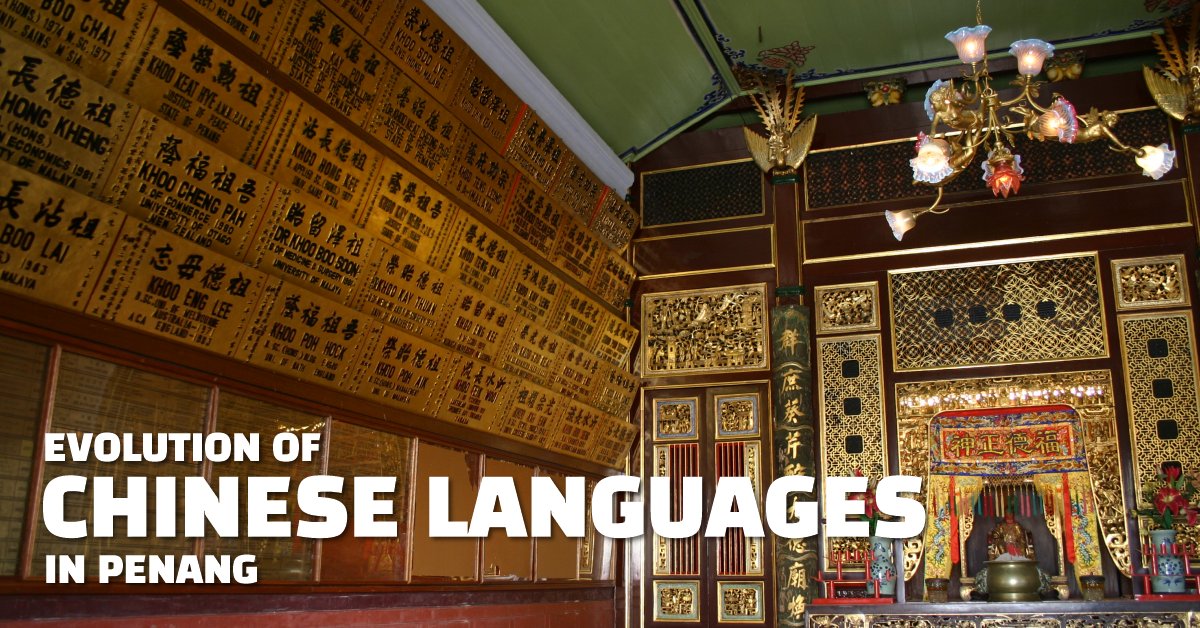 Evolution of Chinese Languages in Penang (28 February 2004)
Evolution of Chinese Languages in Penang (28 February 2004)
The Chinese people in Penang have had to take on various linguae francae to communicate among themselves, from the moment Penang was established in 1786, until present day.
After the people who brought Hokkien to this region fled Fujian Province, the Hokkien in Fujian Province continues to receive and absorb influences from stronger languages, and in the last hundred years, a lot of words and expressions came from Mandarin. As a result, the Hokkien in China bears influences which escape Penang Hokkien. In comparison, the Hokkien in Penang bears influences from Malay, English, other Chinese languages (Teochew, Cantonese, etc.) but remained frozen in time until the 1970s, when more and more parents began sending their children to Chinese schools, causing Mandarinization of Hokkien to accelerate.
Before the 1970s, the Chinese population was roughly split between the English and Chinese educated, and before the dawn of the 20th century, English language practically monopolized mainstream education. Back then, Chinese education was "off mainstream", provided by the various clan associations to the children of the clansmen. They were taught Literary Chinese pronounced in their mother tongue. So if the mother tongue is Hokkien, it would be Literary Chinese* in Hokkien, ditto Teochew, Cantonese, etc. The Chinese people in Penang practised a phenomenon known as diglossia - they speak their mother tongue at home (that could be Hokkien, but it could also be Cantonese, Teochew, Hakka, etc.), they speak Hokkien in the market, and they speak English with the British administrators.
*I use the term "Literary Chinese" to mean the form of Classical Chinese that was used by the Chinese people to communicate among themselves in writing.
The majority of migrants arriving in the 3rd quarter of the 19th century were penniless and illiterate. Whether the immigrants came from Zhangzhou, Quanzhou, Xiamen, Chaozhou, Taishan or Guangdong, the need to communicate among themselves means they have to agree on a lingua franca. The dialect of the Zhangzhou settlers, who had arrived earliest, even before the founding of Penang Island, became the lingua franca, the one used for oral communication.
Qing Dynasty China by the late 19th century was viewed as corrupt and incompetent, so even among the Chinese population of Penang, there was greater prestige attached to learning English. The presence of British schools such as Penang Free School, St Xavier's Institution and the Convent schools give the Chinese population easy access to English education. In comparison, only the elite learned to read and write Literary Chinese, so doing for purpose of commerce with China.
The 1st quarter of the 20th century saw a major transformation of literacy among the Chinese. It happened in China and rippled across the Chinese-speaking universe. It was a time when telecommunication devices were invented and introduced. Audio can then be transmitted across vast distances, and behind it, came movies, telephone and television.
For hundreds of years, the Chinese people have been using Literary Chinese to communicate. That was before the age of telecommunication. But that was a "Tower of Babel" because although the writing system is the same, every region pronounces the Chinese characters its own way. In the past, it was not possible to standardize pronunciation across vast expanses, hence the proliferation of dialects and languages. Telecommunication devices made it possible. But with that, came also the need for a standard way to speak.
After the fall of the Qing Dynasty and the establishment of the Republic of China, the Commission on the Unification of Pronunciation convened in 1912. This lead to the Dictionary of National Pronunciation (国音字典/國音字典) which was published in 1919. It was the beginning of the end of using Literary Chinese, and towards introducing a language that is spoken the same way it is read. After much deliberation, the members of the National Language Commission decided on using the Beijing dialect as the base for the standard national pronunciation, partly because of its geographic location at the centre of Chinese administration. That gave birth to Standard Chinese, also known as Standard Mandarin, or simply, Mandarin.
In 1932, the National Language Commission published the Vocabulary of National Pronunciation for Everyday Use (国音常用字汇/國音常用字彙), gradually bringing the different peoples of China towards using the pronunciation of Chinese characters that follow the Beijing dialect.
Even through the various civil wars and political upheavals, the movement towards a common pronunciation or putonghuà continued. Schools not only in China, but also in Malaysia, and of course, in Penang, began to switch from teaching Literary Chinese, to teaching Mandarin. And for the purpose of unity as one people, the Chinese schools suppressed the use of other Chinese languages in favour of Mandarin. For purpose of political exigencies, that was done not only in China, but also in other countries including Taiwan, Singapore and Malaysia, and of course, it happened in schools in Penang. Places like Hong Kong held on, for as long as it could, until reunification opened the door for Mandarin to enter.
In Penang, Mandarin gradually supplanted both Penang Hokkien and English as the lingua franca among the Chinese, a movement that is being viewed by many with concern, if not alarm. The importance of Mandarin should of course not be ignored, however, in my personal opinion, it should not be at the expense of Penang Hokkien, English, and many Chinese languages that are now endangered.
Learn Penang Hokkien is my personal effort to give Penang Hokkien relevancy in the 21st century, so that we can speak it with pride, and able to communicate in it, in writing. Penang Hokkien is greatly handicapped by not having a writing system. In the past, it can survive because the population at large does not need to communicate in writing. But in this present age, society telecommunicate extensively, not only over the phone, but also through Facebook, WhatsApp and Telegram, among others. It is therefore essential for speakers of Penang Hokkien to learn a writing system, so that they can communicate among themselves, and the writing system has to be so easy to write, that they can do it on any keyboard. It is truly a tall order, but for the sake of ensuring the survival of Penang Hokkien, it is an effort worth taking.
References
https://en.wikipedia.org/wiki/Classical_Chinesehttps://en.wikipedia.org/wiki/Diglossia
https://en.wikipedia.org/wiki/Standard_Chinese#Modern_China
Learn Penang Hokkien
DetailsLanguage Learning Tools
Use the following language learning tools to learn Penang Hokkien!Learn Penang Hokkien with uTalk
This app opens the door to over 150 languages.Return to Penang Hokkien Resources

Copyright © 2003-2025 Timothy Tye. All Rights Reserved.

 Go Back
Go Back

